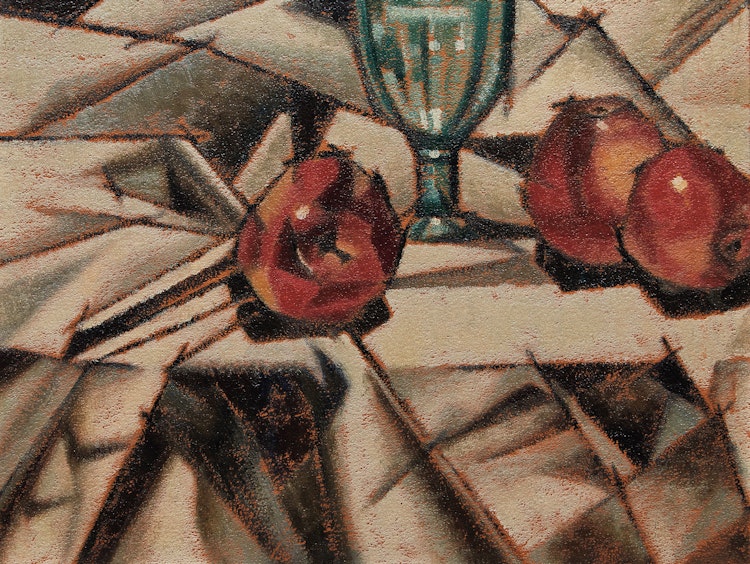Still Life with Apples and Glass by Bertram Richard Brooker

Bertram Brooker
Still Life with Apples and Glass
oil on board
signed lower right
11.5 x 15 ins ( 29.2 x 38.1 cms )
Auction Estimate: $9,000.00 - $12,000.00
Price Realized $20,400.00
Sale date: December 3rd 2020
Private Collection, Ontario
James King, “Bertram Brooker: Life and Work” [online publication], Art Canada Institute, Toronto, 2018, page 41
The still-life genre was a traditional touch point the artist often returned to while exploring the material and immaterial. Discussing a similar work to “Still Life with Apples and Glass” entitled, “Still Life with Lemons (1936)”, James King notes: “The two lemons, the squash and the dining table cloth have an almost palpable texture; yet the bowl, its shadow, and the background are rendered with precise abstract lines that seem to remove these elements from the reality of the others in the composition. Thus the viewer is forced to question what is being viewed.” By the 1930s, Brooker had largely abandoned pure abstraction in favour of a hybrid of figural and natural forms. In both works there is a tension between the cubist abstraction of the background linen forming very precise hard edge folds and draping, compared to the softened smooth texture of the apples and glass goblet.
Not dissimilar to the early abstraction works by Kathleen Munn, there is an experimental quality in Brooker slicing the image plane with bold geometric outlines heightened with dramatic contrast. There is an even balance within the composition, perhaps thanks to an exploration into dynamic symmetry and the process of building a proportionally balanced work with the compositional elements. A master of rendering fabric in a decidedly modern geometric style, Brooker has given equal weight to both the physical objects of the apples and goblet as to the patterned folds of the linen. A modern artwork, “Still Life with Apples and Glass” is testament to Brooker’s avant-garde practice influencing future artists, which firmly cemented his unique position within Canadian art history.
Share this item with your friends
Bertram Richard Brooker
(1888 - 1955) Canadian Group of Painters, RCA
Born in 1888 in London, England, Bertram Brooker was one of Canada’s first abstract painters. Brooker attended school until age twelve when he went to work as a domestic servant at Fuller’s Dairy. Brooker had an early interest in art and music. His first painting was a watercolour from 1899 featuring exultant Christ. Unfortunately, this work does not survive. Brooker was a choirboy at the St. James Anglican Church in Croydon. In 1905, Brooker’s family immigrated to Portage la Prairie, Manitoba. Here, Brooker worked with his father at the Grand Trunk Pacific Railway.
In his early twenties, Brooker traveled to England and New York City. On this trip he probably encountered modern theatre and contemporary art, such as the first Post-Impressionist exhibition organized by Roger Fry in 1910. From 1911-14 he was active in the local theatre community and directed a play called Much Ado About Something. In 1914, Brooker became the editor of the Portage Review. He would later work as a designer, music and drama editor, and director for various newspapers in Winnipeg and Regina. In 1920, Brooker and his brother moved to Brandon, Manitoba, and opened a cinema in the Neepawa Opera House. Brooker wrote and sold several scripts about a detective, Lambert Chace, while in Brandon. Three of these films survive.
In 1921, Brooker moved to Toronto to work at the Globe and at Marketing. Three years later, Brooker purchased Marketing and became the publisher and editor. In 1927, Brooker sold the company back to its original owner. In 1929, Brooker began working at J.J. Gibbons Advertising Agency. He worked there until 1936 where he was hired at MacLaren Advertising, where he worked until 1955, and eventually became the Vice-President of the company.
While visiting a Presbyterian church in Dwight at the Lake of Bays in Ontario, Brooker experienced a moment of awakening and came to understand that the role of artists was to instruct society on getting in touch with their spiritual values. He began creating nonfigurative paintings in tempera that were inspired by his enlightenment at the church. The style adopted by Brooker was indebted to a group of English artists who were inspired by the Futurists known as the Vorticists, and Brooker used abstract shapes to suggest violence and movement. Painting in this way allowed Brooker to express the spirituality that he was trying to understand.
In 1923, Brooker met Lawren Harris and was sympathetic to the Group of Seven’s nationalist agenda, but he thought their view of the wilderness was too limited and that there were countless other ways for creating Canadian art. Both Harris and Brooker were interested in infusing spiritual values into paintings. Sponsored by Harris and Arthur Lismer in 1927, Brooker’s abstracts were given their first solo show at the Arts and Letters Club. Brooker’s radical paintings did not resonate with the viewers and was widely criticized. Until 1931, Brooker showed his art with the Group of Seven due to his compatibility with their aims.
Despite his artistic accomplishments, Brooker saw himself as a writer. However, Brooker continued to paint regularly and had an in-home studio. During the summer of 1929 Brooker met representational artist Lionel LeMoine FitzGerald. Inspired by FitzGerald and his own long-established passion for abstract art Brooker began expanding his style. It was at this time that he explored various genres, such as the nude and still lifes. Brooker never promoted his work to museums or dealers, and much of his work remained unsold during his lifetime.
Literature Source:
James King, “Bertram Brooker: Life & Work”, Art Canada Institute, Toronto, 2018 (https://aci-iac.ca/art-books/bertram-brooker)
We extend our thanks to Danie Klein, York University graduate student in art history, for writing and contributing this artist biography.

